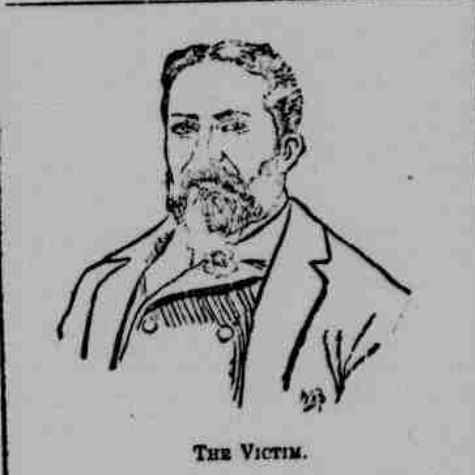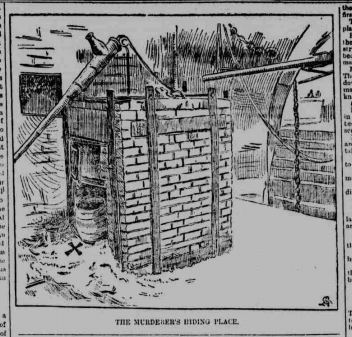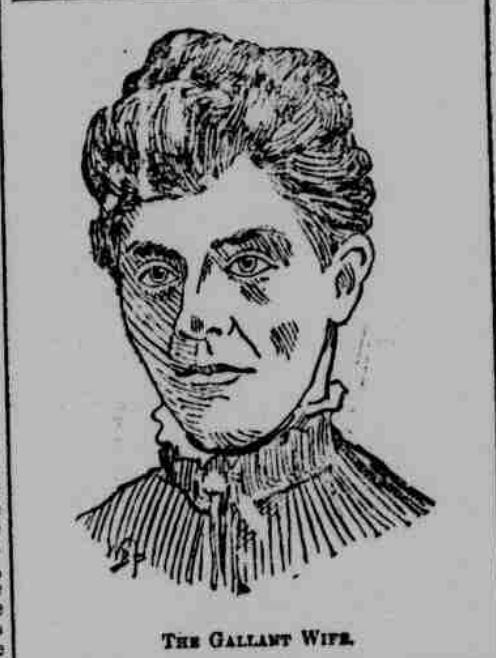Life can change in an instant. Things can happen suddenly, which can never be undone. And death can be ready to embrace you. Consider Frederick Kent. Consider Thomas Allen. Or rather, consider whoever Thomas Allen may have been.

It was 10 February 1889 and in spite of all the difficulties that were gathering around Thomas Allen, there seemed to be the genuine possibility of a moment’s escape.
He claimed to be a South African seaman, about 34 years old. When he wasn’t working – which was frequently – he lodged with Mary Shepherd in Plasmarl but was not very good at paying his rent. However, when he went out in the snow on that Saturday night, he promised to come back with money for the rent.
He went drinking in the Queen’s Hotel in Burrow’s Place and thought perhaps that he had got lucky. He later claimed he had met a girl there who told him to meet her in a room in the Gloucester Hotel, just down the road in Gloucester Place. She told him exactly which room to go to. If we accept for a moment that this was true, who was the girl? If she did exist, was it genuine invitation to breathless passion or was it nothing but a prank? Was she motivated by a true generosity of spirit? Was she trying to get rid of him? We shall never know, for the girl disappeared and was never identified. But Thomas Allen’s defence was based upon the suggestion that he felt he was on to something.
Off he went, apparently emboldened by expectation, and made his way quietly upstairs. Some might say that he had no right to be there but he believed he had been invited. Then, perhaps oddly, when he heard noises he hid under the bed and went to sleep. This proved to be a terrible mistake.
Mr and Mrs Kent, the proprietors of the Gloucester Hotel went to bed as normal, in the room they shared with their baby. They carefully secured the hotel and, as an added precaution, locked their bedroom door. After all, they lived in a challenging area in the docks and were keen to keep the ruffians out. There had been four recent burglaries at the Hotel. There was always plenty of cash about since Fred Kent was the local agent for a brewers in Burton. He also managed other houses in the town and kept the money under the mattress. They took £50 upstairs with them that night, and, as always, placed a revolver beneath the pillow. Clearly they had no need to reach for the chamber pot that night, an example if it were needed, of how strict bladder control can have awful consequences.
They were woken at about 5.30 am by a man striking a match in their room. It was a large man. It was a man of African appearance. It was Thomas Allen.
Had they had an opportunity to consider the circumstances, they might have felt his appearance inside a locked room, striking matches, was excellent material for an entertaining murder mystery. However there was no opportunity for such reflections. Fred leapt from his bed. There was a struggle. Mrs Kent found the pistol, lit a candle and fired at the intruder. She was sure she had hit him, because he fell to the floor. He was up again though and threw a mirror at Fred before he managed to unlock the door. He fled, leaving Fred Kent bleeding from three deep slash wounds from a razor which was found on the floor. It didn’t belong to Fred and neither did the hat and shoes they found. The police and medical assistance were called but the poor man bled to death before 8.00 am.
The police followed tracks in the snow, armed with sort of description that was fairly distinctive. They led into the South Dock where Thomas Allen was eventually detained by Edward Charles who was an engine driver in the docks and had previously helped to detain Thomas Nash who allegedly threw his daughter off the pier in 1888. He found Allen hiding in a shed with the ugliest set of features I have ever set eyes upon. He was covered in blood, much of which was not his own. He had been shot in the thigh. Fred Kent had been slashed across the throat and stabbed in the chest. If the police hadn’t turned up the crowd that had so quickly gathered would have lynched him.
He apologised for what he had done, trotting out the story of an assignation that didn’t happen. When the gentleman spoke to me I did not like to tell him that the girl asked me to come there.
Those shoes in the bedroom and the hat were his and he confessed to the killing. There wasn’t much else to discuss.
In court there was some discussion about Allen’s motives. He’d been drinking in the Queen’s Hotel and left at 10.15pm on the Saturday night, leaving three drinks on the bar which he hadn’t paid for and saying he would be back in five minutes. Was this Thomas Allen the confident accomplished lover or Thomas Allen the burglar, off to get money for his bar bill and his rent? Was it therefore nothing more than a robbery that went wrong? But if it was a robbery, why did he strike a match in a dark bedroom? So perhaps his story about the girl was true. But there could be no question about his guilt. His only defence was that he had no criminal intent. But what he did was not contested.
Any argument that he had acted in self-defence would be unconvincing since he shouldn’t have been there in the first place. He pleaded “Not guilty,” largely because he didn’t intend to do it. In fact he had written to Mrs Kent and explained that he had no intention to kill your boss. He claimed that he had gone upstairs when drunk, that the girl who sent him there never turned up and he had fallen asleep. The defence claimed that he was merely trespassing and that Kent had over-reacted. All Allen had done was to defend himself against a disproportionate assault. They should have asked him what he was doing there. But the possibility that this was a robbery that had gone horribly wrong could not be discounted. The prosecution’s case was based entirely upon his shortage of money.
They couldn’t find the girl he claimed invited him to the hotel. He accused the Kent’s two servants, Annie Bennalick and Elizabeth Goss, of luring him there. When they denied ever having met him he said that it was therefore a girl who looked like Goss. He then said it was Annie Taylor who had tempted him. She was in custody herself at the time of the trial for letting a man hug her in the street (which I suspect might be a euphemism) and she denied it. Why would she invite a man to take his boots off and wait for her in a house where she did not live?
Whatever the reason, Frederick Kent had been killed by a stranger in his own bedroom.
Allen was found guilty and executed in Swansea gaol on 10 April 1889.
In the days before his death Thomas Allen wrote to Mrs Kent again, this time asking for her forgiveness. She replied to the Governor saying as I hope to be forgiven for my sins, so I forgive him, which may have brought him some comfort.
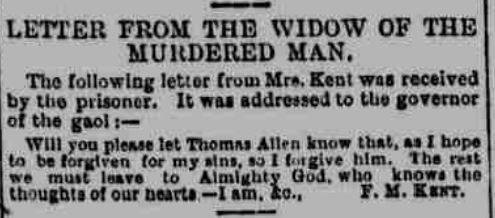
Allen’s past was slowly uncovered. He had been tried for offences against the law of property on five or six occasions and had been imprisoned four times, once for theft in Barnstaple. A year earlier he had been arrested for trying to pass a forged cheque in Exmouth. He wasn’t a sailor at all. He was an itinerant shoemaker called Leon Pinzulu, though he sometimes used the name James Emmanuel Johannes, and he came from Santa Cruz, though which one isn’t clear.
Public opinion shifted slightly in the run up to the execution, with a petition raised in hope of a reprieve. There had never been any intention to murder, they said. It was gruesome but it was manslaughter. But the petition failed. Over 1000 people took part in a vigil outside the prison on the morning of his death.
Sadly, it was not a straightforward execution. It is said that he had a strong neck and he shook violently for almost three minutes. Executioner Berry was adamant that death had been instantaneous, but observers were not convinced and the Prison Surgeon identified the cause of death as ‘strangulation.’
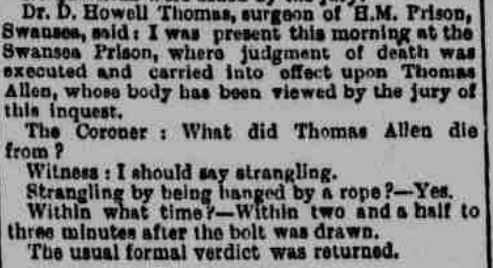
My version of this tragic story has not been published previously. However, the Gloucester Hotel does feature importantly in my second Rumsey Bucke novel, Our Lady of Mumbles.
Click on this link to find out more about Our Lady of Mumbles
Click on this link to go to the How To Buy Page
I have now received new stock of my book Swansea Murders. Go to the Swansea Murders page in the menu or by clicking on this link, to find out more. The book contains 25 crimes which were committed between 1770 and 1946.
You can go straight to the How to Buy Page by using the menu or by clicking here.

